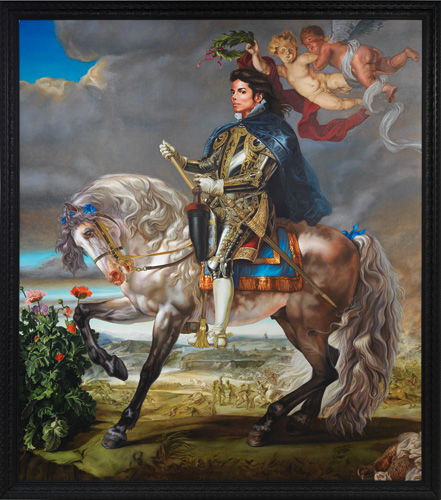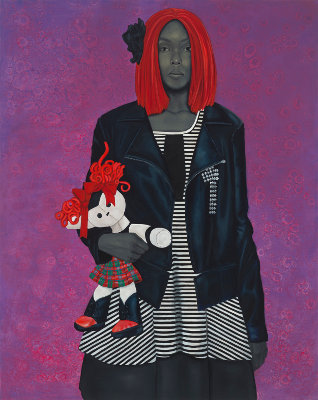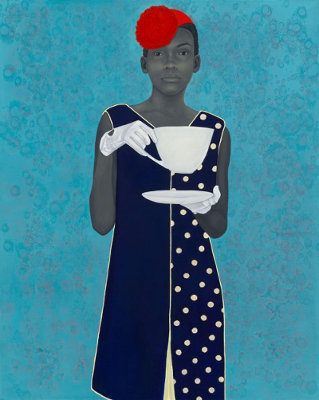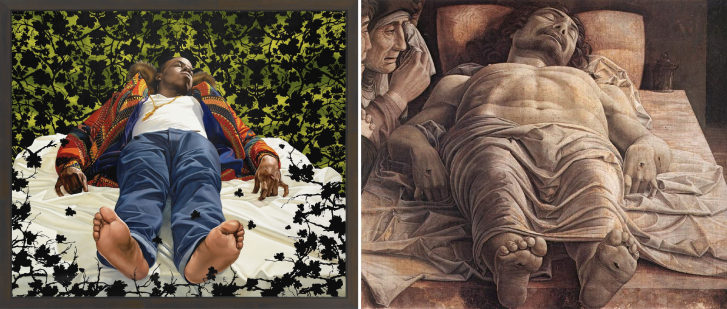At the end of each presidency the Smithsonian commissions an official portrait of the outgoing royals for the National Portrait Gallery. Museum curators advise, suggesting names to suit the sensibility and self-image of the couple. Barack and Michelle Obama have each selected their individual immortalizers. Kehinde Wiley will collaborate with the former president on his own iconography. Amy Sherald will work with the former first lady on hers.
Final commentary awaits delivery of the finished products. Meantime, there are things to be learned by looking at the signature styles that brought Mr. Wiley and Ms. Sherald to curatorial attention. And which appealed to the Obamas. Since a formal portrait is envoy for the person it represents, an individual’s choice of portraitist is a statement in itself. The Obamas’ choices signal the primacy of identity politics over traditional likeness.
 [1]
[1]Identity Politics
Both artists are the first African Americans commissioned for a presidential portrait. On one level, that is a fitting and welcome pick. The heart of things, though, is less genial. While racial identity asserts itself most aggressively in Wiley’s painting, likeness is ancillary to race in the work of both artists. Each offers the same coded rationale for painting only non-white subjects: a desire to paint “people who look like me.”
Barack Obama himself popularized the look-like-me meme. He opened his 2013 address at Berlin’s Brandenburg Gate with: “Angela and I don’t exactly look like previous German and American leaders.” Significance accrues to identity (first female chancellor, first black president) ahead of any mention of the goals and means of governance.
Skin color, indispensable for grievance signaling, is Wiley’s essential subject. Wiley’s portraits are tongue-in-cheek pilferings from art history that insert black figures, often urban hip-hopsters, into recognized compositions. A social justice rap lends a patina of intellectual authority to conceptual gags descended from Cindy Sherman’s impersonations of famous figures begun in the 1970s. Wiley calls his appropriations “remix culture” —visual riffs on the turn-table techniques of the ‘70s hip-hop scene.
Wiley parodies historical European court painting and religious iconography to call attention to the absence of African Americans in it. The incoherence of that intention is lost on an audience raised on Facebook. History, like one’s homepage, exists as an extension of oneself. It is a performance that provides a usable ID.
Adept in the lingo of what he calls “the politics of representation,” Wileygoes full bore Camp. Susan Sontag tagged it in the mid-Sixties: “The essence of Camp is its love of the unnatural: of artifice and exaggeration.” It has been a badge of identity for gay and feminist artists since Larry Rivers painted “Napoleon: the World’s Second Greatest Homosexual” (1964); and Judy Chicago elevated female achievement to a series of box lunches in “The Dinner Party” (1974).
Wiley injects a semblance of novelty to the by-now-customary assaults on the Western canon—almost entirely the achievement of straight white males—by adding race to the mix. In the end, his Camp routine is an exercise in bad faith. All pose and attitude, it is an art of resentment. And erasure. Western civ has got to go, one painting at a time. And there is always room for one more custard pie.
 [2]
[2]A Subtler Preoccupation
Though modulated in a lower key, preoccupation with race dominates Sherald’s work as well. Interviewed by the NEA in 2016, she explained:
It came naturally to paint people that looked like me, but then I also recognized that the art history books that I looked up weren’t culturally relevant. The images [of people who looked like me] weren’t there.
The tenor of her interview with Huffpost last year was similar: “I’m depicting the many people who existed in history but whose presence was never documented.” Implicit in Sherald’s statement is a plaintive reproach that satisfiew the needs of identity politics in the here-and-now but inhibits understanding of the past. As historians know, the mass of the world’s peoples—the laboring poor of every race and ethnicity—do not leave behind the kind of evidence that survives the ages.
Happily, Sherald is a better artist than her obligatory nod to the idolators of difference indicates. She grants her figures a formal dignity very much their own, untouched by the barbed irony that runs through Wiley’s oeuvre. Racial rhetoric notwithstanding, her portraits summon a human presence with genuine sympathy.
 [3]
[3]There is much to like in Sherald’s linear austerity and coloristic liveliness of costume. Her paintings are schooled variations on American folk portraits. The figures maintain the stiff frontality and blank backgrounds common to naive portraiture through the 1700s and 1800s. Her flat, simplified forms carry the decorative charm of their historic antecedents: Erastus Field (c. 1830s), Ammi Philips (d.1865) and the itinerant limners, many anonymous, who sought a clientele outside urban centers throughout the Northeast.
Identity politics asserts itself differently. She turns her figures into racial emblems by eliminating any range of living skin tone. Her subjects are literally black—dark gray, to be precise. The device is more subtle than it seems. Every student of the figure learns, in mixing color on the palette, that black bodies are not black and white ones are not white. [“No tube black, please. And careful with the titanium white.”] In chromatic terms, her trademark conceit undermines the relevance of skin color in the act of noting it.
 [4]
[4]Consider “Miss Everything.” With her white gloves, elbows clenched to her sides, and that la-de-da cup and saucer, she is wonderfully familiar. Her aura of strenuous propriety evokes a type I know intimately: lace curtain Irish. Anxiety to fit in, to establish a footing above one’s roots, is a strain and goad not limited to African Americans. It is the shared estate of most of us.
Both Sherald and Wiley draw on the conventions of Christian iconography. But they could not be more different in their use of it. Sherald adopts the attributes of the saints to lend narrative suggestion to her portraits. A violin was the identifying symbol of St. Cecilia, patron saint of musician—just so, Miss E has her cup and saucer. Others carry their own iconic motif: a rag doll, a bouquet of balloons, a camera. A woman in t-shirt and jeans holds a toddler on her hip in the manner of a medieval Virgin and Child. Something distinctive in hand or dress hints at a psychology and a life than extends beyond the picture plane.
 [5]
[5]
During a 2015 talk at the Brooklyn Museum, Wiley remarked that “portraits don’t tell us the truth about the people in them.” Not the full truth, certainly. But they do tell something. That elusive something penetrates the pretense inherent in every posed portrait and makes itself visible. At the very least, the Wiley and Sherald commissions will illustrate how the Obamas wish to be remembered. What larger truth rides out the politics of commemoration remains to be seen.
NOTE: This essay appeared first in The Stream [6], under the title “Portraits & The Politics of Commemoration.”